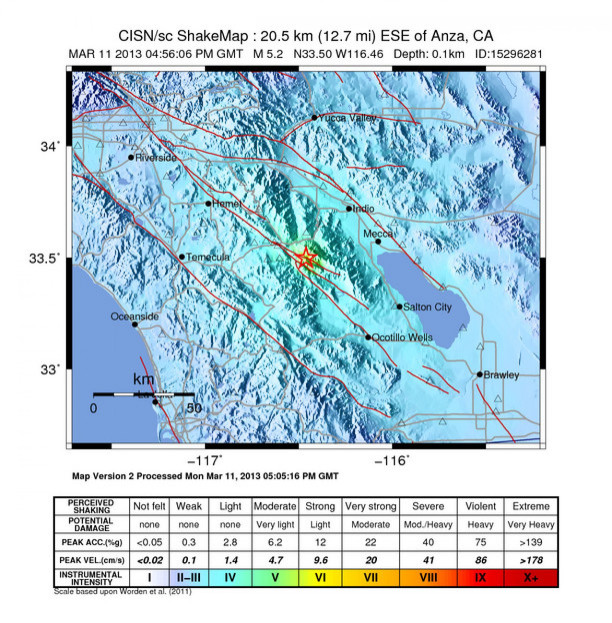4.7-Magnitude Quake Hits Southern California, Tremors Felt In San Diego, LA
An earthquake rattled the Southern California desert on Monday morning, according to the U.S. Geological Service.
The quake’s magnitude was initially estimated at 5.2 but was soon downgraded to 4.7. The quake was centered near the community of Anza, Calif., but tremors were felt as far as 65 miles away in San Diego and there were some reports of shaking 100 miles away in Los Angeles. There are no immediate reports of damage.
Monday also happens to be the two-year anniversary of the Tohoku earthquake off the coast of Japan that created a devastating tsunami and led to a major disaster at the Fukushima Daiichi nuclear plant.
Update 3:17pm Eastern: USGS seismologist Susan Hough told the Los Angeles Times that Monday's quake is the largest centered in the greater LA region since a magnitude-5.4 temblor struck in July 2010.
Monday's quake originated about 7 to 8 miles below the surface, 2 miles deeper than typical earthquakes, Hough said, according to the LA Times. The vibrations from a deep quake travel farther, but are less likely to generate aftershocks.
Update 2:42pm Eastern: Early data suggests the quake occurred on one of the branches of the highly seismically active San Jacinto fault zone, which is part of the larger San Andreas fault system.
Pat Abbott, a professor emeritus of geology at San Diego State University, warned residents to be on the lookout in an interview with a San Diego NBC affiliate.
“There’s always that slight chance – slight chance now - that this could be the foreshock of something larger. Probably not. Usually this is just an event all by itself,” Abbott told NBC. “It doesn’t hurt to keep it in mind, in the next 72 hours in particular. If a larger one is going to occur it would probably be during that three-day period.”
Update 1:45 pm Eastern:
The USGS ShakeMap for the quake shows that weak to light tremors (shown in shades of blue) were felt all across the region:

Also, you might be wondering: How can an earthquake get downgraded? NBC News writer Jeff Black explains, quoting USGS spokesperson Leslie Gordon:
"The initial magnitude reports are generated by computer and automatically sent out," Black writes. "Those reports are revised after data are reviewed by USGS seismologists."
If you felt this morning's earthquake, the USGS wants to know.
© Copyright IBTimes 2024. All rights reserved.





















